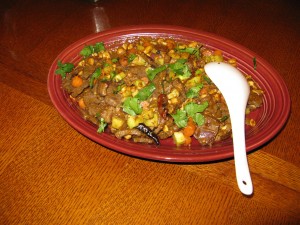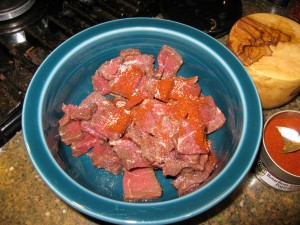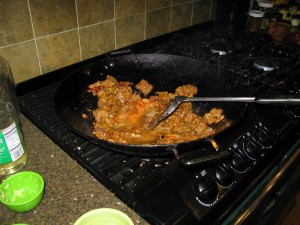Whiskey Smoked Kung Pao Beef
One night last month, I got it in my head to make Kung Pao Beef.
Which is a good thing, normally, but you see, when I went to the pantry, I realized that not only did I not have any Shao Hsing wine, I had no dry sherry either. Horrors! Bad, bad, bad chef, bad cook, bad blogger, bad, bad, bad.
But, I really wanted Kung Pao Beef. So, I went digging around to see what I -did- have in the pantry of an alcoholic nature. Zak has tequila about so he can make a margarita now and then when he gets a hankering for limey, salty agave goodness. But, the thought of tequila mixed into Kung Pao did not thrill me.
There was red wine in the pantry, but uh, no, I passed that right up. Rum, ditto. Benedictine–I thought seriously about that one, but I decided that the distinctly medicinal flavor of the herbal liquor would clash horribly with chilies, peanuts and soy sauce. In fact, I can feel my tongue shudder at the thought even as I type these words. No Irish Cream. I couldn’t bring myself to use any of the Grey Goose vodka that is stashed in the freezer for medicinal purposes, but what I did find was a mostly full bottle of Jameson Irish Whiskey, which is my drink of choice if I am to drink. (Because of my medication, I can’t really enjoy alcohol, so I content myself to a shot of good whiskey every other month or so.)
And that bottle of whiskey looked mighty lonely and I began to think.
There was a thought niggling at the back of my head that in one of my older Chinese cookbooks in my collection of out of print goodies upstairs I had read that sometimes it was acceptable to use whiskey as a substitute for Shao Hsing wine, though the author wasn’t really hot about the idea herself. And as I thought, I also remembered reading about a chef in a Hong Kong restaurant that used whiskey to flame a special dish–some chicken preparation as I recall. And of course, I had heard of whiskey chicken soup, to be consumed after the birth of a child.
(It turns out that the book I read that bit about substituting whiskey for rice wine is Secrets of Chinese Cooking by Tsuifeng and Hsiangju Lin, the wife and daughter of influential Chinese author Lin Yutang. The book was published in 1960, and in its day, helped to popularize Chinese cookery in the United States. It is still filled with good information and lively writing today. If you can find a copy, pick one up, it’s well worth reading.)
So, I picked up the bottle opened it and sniffed it. The characteristically flowery scent of Irish whiskey filled my nostrils and I thought about it and decided, “I think it will work.”
And so, I poured a shot and a half into a glass and went on preparing my ingredients.
I noted avidly that when I tossed the whiskey into the wok, I didn’t have to tip the rim of the wok into the fire to get it to flame–the distilled spirits caught fire immediately and flared to life in a dancing tongues of blue and gold writhing like insubstantial serpents over the beef.
And when we sat down to eat it, Zak noticed the difference immediately–it was smokier in flavor and aroma than my usual recipe, and somehow the flavors of the beef, vegetables and peanuts seemed clearer and stronger. He, Kat and I liked it even better than the way I usually made Kung Pao, but it still wasn’t perfect, so my mind went to work on how to improve the flavor profile of the dish even more.
Which is how this recipe was born. It started out with the substitution of one ingredient for another, and ended up with the addition of a completely different ingredient that isn’t Chinese at all, and the substitution of one version of soybean paste for another, such that while I still call this Kung Pao Beef–and it still tastes unmistakably both Chinese and Kung Paoish, it doesn’t taste like any other version of the dish I have ever eaten anywhere.
When I made it again with all of these changes and took photographs of the cooking process to share it here with you, I decided to use Morganna, who is still working as a line cook at one of the fine dining restaurants here in town and who is developing into quite the chef herself, as a guinea pig. Well, actually, she showed up at the door unexpectedly and I popped a piece of the beef in her mouth as I was putting away the leftovers before I even really said hi to her. Even cold, she chewed it up with a blissful expression and then said, “Best. Kung. Pao. Ever.”
So, I am thinking, that while it may not be traditional at all, and it may technically be a fusion dish–this Kung Pao is still recognizably Kung Pao, so a new name wasn’t necessary–just two qualifiers–“whiskey” and “smoked.”
What are the other changes I made in the dish?
Well, you might think I’m a bit off my nut, but I marinated the beef in not just some sugar, cornstarch, soy sauce and whiskey–I also added about a teaspoon of smoked paprika. Specifically, paprika that was smoked over old bourbon barrels by a Kentucky company called Bourbon Barrel Foods. Their smoked paprika is rich, deep red and amazingly haunting in flavor. Very smokey, but sweet and somewhat floral as well.
And, instead of the little bit of hoisin sauce that I usually add to the wok near the end of cooking, I substituted ground soybean sauce–the brown kind, not the yellow. I also used both dried tien tsin chilies and fresh cayenne chilies to add heat to the already smokey dish. I cut back on the sugar a bit and tweaked the amount of vinegar in the sauce as well, so that when I scraped the steaming contents of the wok onto the serving platter, each bit of beef and vegetable and peanut was just glazed with a shimmering reddish brown sauce, with very little left to pool on the plate below.
The only thing that frustrated me while making this version of Kung Pao was trying to catch an image of the flames in the wok with my camera while still tending to the stir frying. I think I lost my touch–I used to be able to stir-fry left handed while photographing right-handed and get some great action shots. Not so much anymore–I only got one shot of fire in the wok, and of course, it is after the flames had died down to a warm orange glow that is not nearly so dramatic as vibrant blue and gold!
But that’s okay. I can always try again the next time I cook it! And this time, I’ll be sure that Zak distracts Kat elsewhere–she wasn’t too thrilled by Mommy nonchalantly setting stuff on fire in the kitchen–I think she was rather put out by the entire idea.
Though, I must note, it didn’t stop her from eating plenty of the results of those flames when it was all over.
Whiskey Smoked Kung Pao Beef
Ingredients:
3/4 pound top round, cut into very thin (1/4″ thick) slices across the grain, and then into pieces 1″ square
1 tablespoon whiskey
1 teaspoon light soy sauce
1/2 teaspoon raw sugar
1 scant teaspoon smoked paprika
1 tablespoon cornstarch
3-4 tablespoons peanut or canola oil
1 small red onion, peeled and cut into 1/2″ dice, then separated into squares
5-10 dried tien tsin chilies
pinch of ground Sichuan peppercorns
3 cloves garlic minced
1 1/2″ cube ginger, peeled and minced
2 fresh cayenne chilies, cut into thin slices on the diagonal
1 ounce shot of whiskey
1 tablespoon dark soy sauce
1/2 cup carrots peeled and cut into 1/4″ thick rounds
3/4 cup broccoli stalk, peeled then cut into quarters lengthwise, then into 1/4″ thick wedges
1 teaspoon ground bean sauce
scant 1/4 cup chicken broth
2 teaspoons chiangking black rice vinegar
1/2 cup unsalted dry roasted peanuts
1/4 teaspoon sesame oil
cilantro leaves for garnish
Method:
Toss beef in a bowl with whiskey, soy sauce, sugar, paprika, and cornstarch and allow to marinate for twenty minutes while you prepare the rest of the ingredients.
Heat wok over high heat until a thin whisker of smoke swirls up from the surface and the smell of hot metal wafts to your nose. Add peanut or canola oil and allow to heat for another minute, or until the oil shimmers and ripples slightly on the bottom of the wok.
Immediately add the dried chilies and onions, and cook, stirring vigorously, until the onions brown slightly and the chilies darken. Add the beef, reserving any liquid marinade still in the bowl. Spread the beef out into a single layer over the surface of your wok and sprinkle the Sichuan peppercorns, garlic, ginger and cayenne chilies over the top of the meat. Leave the meat alone, undisturbed on the bottom of the wok to brown well for at least a minute. Then, stir fry for about another minute, stirring constantly, until the beef is seared with very little pink still showing.
Stand well back from the wok and toss the shot of whiskey in. If your flame is high enough, the dish will flame on its own. If not, you can quickly tip the wok slightly, dipping the rim toward the flame and it will catch fire.
Note: Please have the wok lid and baking soda ready to smother flames–NOT water– and be careful. AND, whatever you do–do not pour the whiskey directly from the bottle into the wok–freak accidents that involve alcohol vapors igniting the liquor in the bottle while you are holding it can and do happen. Also, please have your exhaust fan running and if you don’t have one of those–don’t flame stuff in your kitchen. And, please know where your fire extinguisher is. Now that I have terrified you and sounded like everyone’s nervous mother, we will continue the recipe.
After the flames die down–which they will do quickly–add the dark soy sauce, and toss the meat well. Then, add the carrots and cook, stirring for about a minute, then add the broccoli stalks. Then, stir in the ground bean sauce and use the chicken broth to deglaze the wok. Be sure to scape all the browned bits off the sides and bottom of the wok into the sauce–they are filled with flavor. Stir in the vinegar and peanuts, then bring the wok off the heat and stir in the sesame oil.
Scrape onto a heated platter and scatter cilantro leaves over the top for a garnish. Serve with steamed rice and if you have it, puer tea.
7 Comments
RSS feed for comments on this post.
Sorry, the comment form is closed at this time.
Powered by WordPress. Graphics by Zak Kramer.
Design update by Daniel Trout.
Entries and comments feeds.






I love the Lins’ book. Their description of dongpo pork is one of the most sensuous bits of food writing I know. It’s worth finding the book just for that recipe.
Comment by Breen — December 9, 2010 #
I sooo want to make this.. I love Kung Pao anything.. what do you think it would do with chicken? I have been trying to stay away from the red meat.. or do you think shrimp would be better?
Comment by Mary Perrine — December 9, 2010 #
Mary, I think chicken would work fine with this–the whiskey and smoked paprika might be too much for the shrimp.
That said, I would bet that if you mixed boneless skinless breast and thigh meat it would be delicious.
Comment by Barbara — December 9, 2010 #
I often use scottish whiskey or even our local plum brandy called slivovitza, which has a lovely fruity character, as a substitute for Shiao Hsing wine
Comment by Sasha — December 9, 2010 #
Slivovitza as a substitute for Shiao Hsing wine? What a great idea. I am headed to the store right now. Bet my boss would this idea too.
Comment by Maureen — December 9, 2010 #
Hi Barbara! So happy to see you back to foodblogging 🙂 This sounds delicious but I only have an electric stove. Any idea how I can adapt it?
Comment by Crazy Radishes — December 10, 2010 #
Crazy Radishes—great name, btw–you can use an Aim-n-Flame lighter–the ones that have triggers and are long and thin–most folks use them on outdoor grills or for fireplaces. That way, your hand is out of the way of the fwoosh of flame that jumps up. Most chefs would say to use a regular match or lighter, but for the first few times you set something alight, I suggest the Aim n Flame–or one of those long fireplace matches.
My only problem with matches is that I’ve seen newbies drop them into the food–and sulfur is not a tasty addition to whatever is being set afire.
Comment by Barbara — December 17, 2010 #